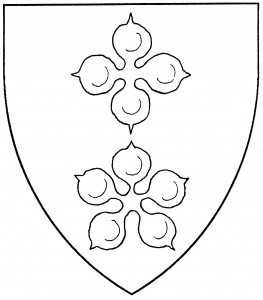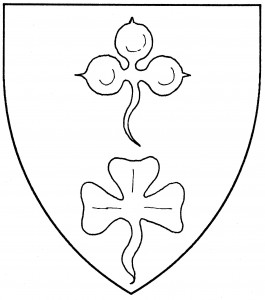While the term “foil” means literally “leaf, lobe”, the term is used here to denote a class of generic flowers. They are not of any natural species, but are highly stylized heraldic charges: the petals are usually drawn rounded, with points at the ends.
The term “foil” is used as a root, with a prefix indicating the number of petals. Thus we have the “trefoil”, with three petals, the “quatrefoil” with four petals, the “cinquefoil” with five, &c. More than six petals (“sixfoil” or “sexfoil”) are uncommon; more than eight petals (“octofoil” or “double quatrefoil”) are not found.
In period armory, cinquefoils were the most common foil-type flower, found as early as c.1244 in the arms of de Umfraville [Asp2 219]. Early heralds made no distinction between cinquefoils and roses, considering both the blazons and emblazons interchangeable (as in the various cadet arms of the Darcy family through the 14th Century). The cinquefoil is sometimes blazoned a “fraise”, or strawberry flower, especially for canting purposes.
Next in popularity were sixfoils, dating to 1255, and quatrefoils, dating to 1244. Trefoils, the most popular form in Society heraldry, first appear c.1254 in the arms of de Perie [Brault 280 and Brault2 28], but in period were not as common at first as the other foil-flowers.
The trefoil is the only foil-flower that is shown slipped by default; the others have no slips unless specifically blazoned. (Even the trefoil has the slip blazoned occasionally, though it’s the Society’s default. It’s also sometimes found double-slipped, which does have to be blazoned.) The trefoil is also the only foil-flower with a definite default orientation, with a petal to chief; period examples of cinquefoils, by comparison, may be drawn with a petal to chief, or a petal to base. Most foil-flowers follow the convention of the trefoil, and are drawn as in the illustrations, with a petal to chief.
A variant on the trefoil is the “shamrock”, the symbol of Ireland; its petals are heart-shaped and have no points. The distinction is purely artistic: no heraldic difference is granted between trefoils and shamrocks. A crowned shamrock, as the Royal badge of Ireland, is not registerable in the Society.
Similarly, the “four-leaved clover” is a Society variant on the quatrefoil, with heart-shaped petals; it is almost always shown with the petals in saltire, even when not so blazoned.
In the English system of cadency, the octofoil is the brisure of the ninth son. For related charges, see rose. See also leaf.
Bevin Fraser of Sterling bears: Vert, three fraises Or pierced vert, on a chief Or a rose gules, barbed and seeded proper.
Olwen of Buckland bears: Azure, a trefoil stalked argent.
Myles of the Shamrock bears: Argent, a shamrock vert.
Elspeth de Stervlen bears: Purpure, six cinquefoils Or.
Johanna le Walkere bears: Quarterly azure and sable, four quatrefoils argent.
Carol of Bellatrix bears: Per bend argent and vert, six octofoils in bend three and three counterchanged, all pierced Or.
Ærne Clover bears: Or, a four-leaved clover saltirewise slipped vert.

